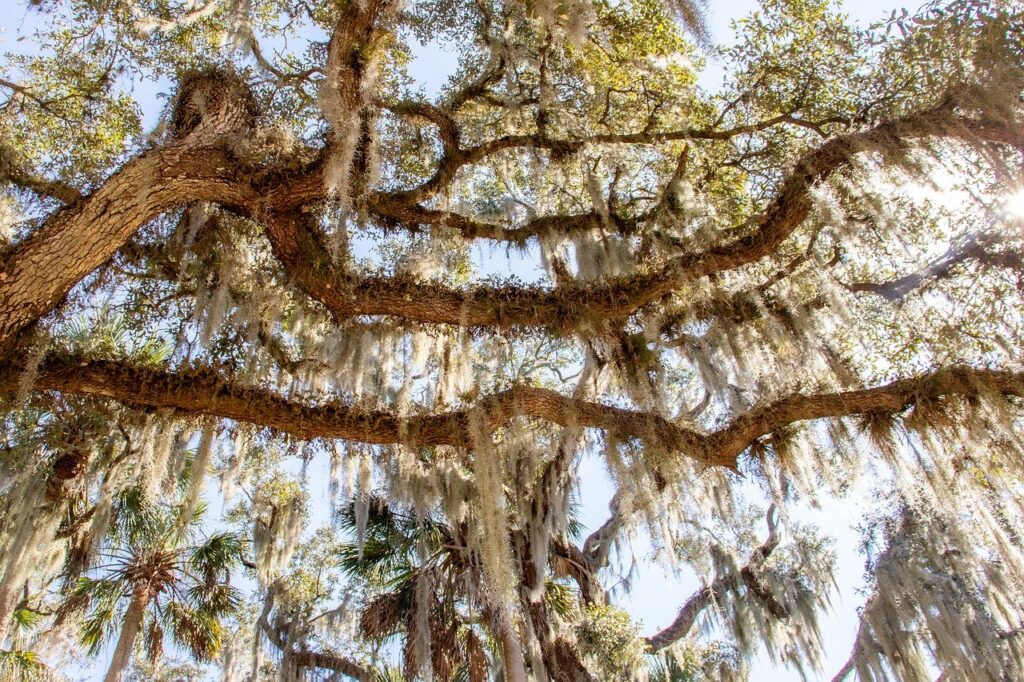January 25, 2023
How to Toss Your Spanish Moss

Fast Facts
Perhaps the most incorrectly named plant in botany, Spanish moss is neither Spanish nor a moss. Rather, it belongs to the bromeliad family, along with succulents. It is also epiphytic, meaning it grows on another plant but creates its own food and does not root or steal nutrients from its host.
Spanish moss prefers moist environments. Its leaves’ surface has cup-like scales that trap and retain moisture, allowing it to survive through dry periods. It is also resilient and able to go dormant in dry weather until moisture resumes.
Say What, Now? Spanish moss is actually a flowering relative of pineapples, which are also bromeliads.
Why Homeowners Hate It
Whether you are in the camp of Spanish moss’s admirers or detractors, it is hard to ignore the detrimental effects it can have on your trees and surrounding landscape.
Get an Estimate
Strains Tree Limbs
As mentioned previously, Spanish moss traps and absorbs water. When that moisture accumulates, it becomes heavy and, as a result, strains your tree’s branches to support its weight. Weak limbs are more liable to break and fall from your tree.
Impairs Tree Health
Draping Spanish moss blocks sunlight from getting to your trees and hinders photosynthesis both for the tree and any grass growing underneath it. Parts of the tree that receive rainfall but no sun are susceptible to rotting.
Hosts Critters
The moisture of Spanish moss creates a hospitable environment for boll weevils, frogs, and spiders. Contrary to popular belief, chiggers, or red bugs, do not live in hanging Spanish moss but are attracted to the moss that falls to the ground, so you should be extra careful when handling fallen moss. Meanwhile, birds carry Spanish moss away for their nests, allowing moss seeds to spread and grow on new trees.
Killing It (Not With Kindness)
Once you have decided you want your Spanish moss removed, there are some guidelines to follow. First, be sure any ladder you use to reach it is secure on the ground, always wear gardening gloves to protect your hands, and enlist the help of a second person who can spot you while on the ladder and hand you the rake you will need to scrape the moss from the tree.
When it comes to killing solutions, three popular types of spray are often touted as useful: potassium, baking soda, and copper.
Potassium
A spray made with potassium bicarbonate works quicker than Copper sulfate, as it is considered a “contact killer.” It will destroy the Spanish moss without hurting your tree and can also be used on roofs or decking. Homeowners may prefer it to Copper sulfate as it does not stain or damage surrounding plants. To make the spray mixture yourself, mix ¼ cup of potassium bicarbonate per gallon of water.
Baking Soda
As with potassium, baking soda will immediately begin killing the Spanish moss once applied, and it follows the same formula as potassium: ¼ cup baking soda (sodium bicarbonate) per gallon of water. While useful for Spanish moss removal, the high salt level in baking soda makes it dangerous for a tree’s new growth.
Copper
Copper sulfate is considered the most effective but slowest solution for removing Spanish moss. It must be carefully used as it is liable to damage a tree’s new or tender growth and harm surrounding plants. Further, it is recommended for open areas, as it tends to stain. Copper sulfate sprays can be bought premixed, or you can mix it with 10 parts water to 1 part copper sulfate and 1 part lime.
Get It Gone With SkyFrog
While the DIY methods listed may work, Spanish moss removal will take a considerable amount of time, effort, and energy. Spanish moss-covered branches are at risk of falling unexpectedly, and you could experience skin irritations if you handle it unprotected. All that to say nothing of the sadness you’ll undoubtedly feel after spending time frustrated over Spanish moss that you could have spent relaxing and enjoying your yard had you relied on your friendly SkyFrog horticulturist.
If you are ready for Spanish moss to be gone from your trees, trust our experts at SkyFrog Landscape. We knowledgeably assess your trees to determine the best course of action, and we safely and efficiently reach even the highest trees on your property – removing the moss while protecting your lawn’s overall health. Contact us today for your free estimate, and get ready to love your yard again!
